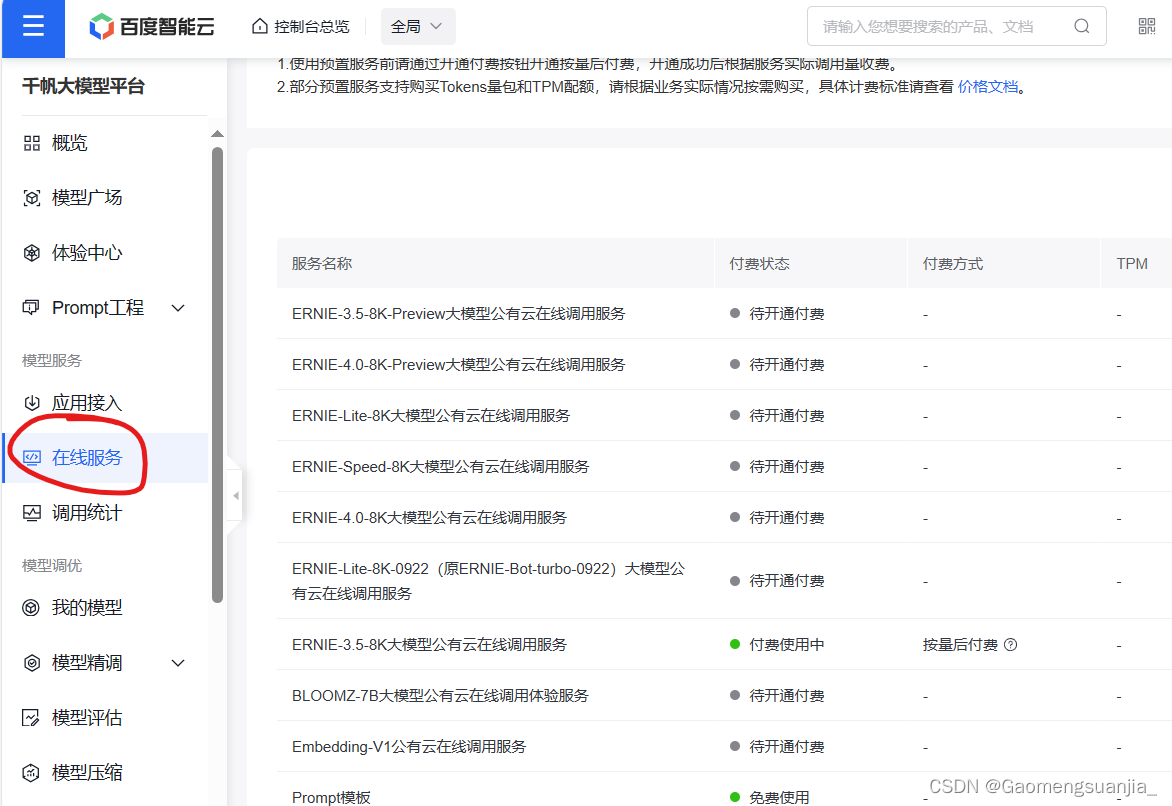Spring Boot后端调用文心一言响应式问答
1.获取文心服务
要在我们的后端服务中接入文心一言,就要获取文心的服务,首先我们要进入百度智能云中注册一个账号:
https://console.bce.baidu.com/qianfan/ais/console/applicationConsole/application
然后点击应用接入,再创建一个应用:

这里的API Key和Sercet Key都是比较重要的,需要把他们保存下来,不过比较好的是,这里的Key都可以多次访问。
紧接着再点击左侧的在线服务选择其中一个开通,这里我使用ERNIE-3.5K:

2.配置相关信息
我们要携带API Key和Sercet Key访问获取获取access_token的接口,再携带access_token和提问访问文心服务器获取回答,大致流程如下:

所以我们要在application.yml配置类中配置一些信息:
这里要替换成自己的,第一步中开通的服务不同,access_token的接口也不同
gaomengsuanjia:
wenxin:
#client_id
api-key: 3Q4deLxxxxxxxxxxHOUWmP
#client_secret
secret-key: mefNTexxxxxxxxxxxxxxxnnN097Tn
#access_token接口
token-url: https://aip.baidubce.com/oauth/2.0/token
#文心服务器接口
chat_url: https://aip.baidubce.com/rpc/2.0/ai_custom/v1/wenxinworkshop/chat/completions
再创建Properties配置类:WenXinProperties
@Component
@ConfigurationProperties(prefix = "gaomengsuanjia.wenxin")
@Data
public class WenXinProperties {
private String apiKey;
private String secretKey;
private String tokenUrl;
private String chatUrl;
}
3.编写Http请求工具类
本次示例我们需要使用HttpClient向两个接口发送http请求,在我们的完整项目中,可能需要多次发送不同的http请求,因此编写一个工具类HttpClientUtil十分有必要:
/**
* Http工具类
*/
public class HttpClientUtil {
static final int TIMEOUT_MSEC = 20 * 1000;
/**
* 发送GET方式请求
* @param url
* @param paramMap
* @return
*/
public static String doGet(String url,Map<String,String> paramMap){
// 创建Httpclient对象
CloseableHttpClient httpClient = HttpClients.createDefault();
String result = "";
CloseableHttpResponse response = null;
try{
URIBuilder builder = new URIBuilder(url);
if(paramMap != null){
for (String key : paramMap.keySet()) {
builder.addParameter(key,paramMap.get(key));
}
}
URI uri = builder.build();
//创建GET请求
HttpGet httpGet = new HttpGet(uri);
//发送请求
response = httpClient.execute(httpGet);
//判断响应状态
if(response.getStatusLine().getStatusCode() == 200){
result = EntityUtils.toString(response.getEntity(),"UTF-8");
}
}catch (Exception e){
e.printStackTrace();
}finally {
try {
response.close();
httpClient.close();
} catch (IOException e) {
e.printStackTrace();
}
}
return result;
}
/**
* 发送POST方式请求
* @param url
* @param paramMap
* @return
* @throws IOException
*/
public static String doPost(String url, Map<String, String> paramMap) throws IOException {
// 创建Httpclient对象
CloseableHttpClient httpClient = HttpClients.createDefault();
CloseableHttpResponse response = null;
String resultString = "";
try {
// 创建Http Post请求
HttpPost httpPost = new HttpPost(url);
// 创建参数列表
if (paramMap != null) {
List<NameValuePair> paramList = new ArrayList();
for (Map.Entry<String, String> param : paramMap.entrySet()) {
paramList.add(new BasicNameValuePair(param.getKey(), param.getValue()));
}
// 模拟表单
UrlEncodedFormEntity entity = new UrlEncodedFormEntity(paramList);
httpPost.setEntity(entity);
}
httpPost.setConfig(builderRequestConfig());
// 执行http请求
response = httpClient.execute(httpPost);
resultString = EntityUtils.toString(response.getEntity(), "UTF-8");
} catch (Exception e) {
throw e;
} finally {
try {
response.close();
} catch (IOException e) {
e.printStackTrace();
}
}
return resultString;
}
/**
* 发送POST方式请求
* @param url
* @param paramMap
* @return
* @throws IOException
*/
public static String doPost4Json(String url, Map<String, String> paramMap) throws IOException {
// 创建Httpclient对象
CloseableHttpClient httpClient = HttpClients.createDefault();
CloseableHttpResponse response = null;
String resultString = "";
try {
// 创建Http Post请求
HttpPost httpPost = new HttpPost(url);
if (paramMap != null) {
//构造json格式数据
JSONObject jsonObject = new JSONObject();
for (Map.Entry<String, String> param : paramMap.entrySet()) {
jsonObject.put(param.getKey(),param.getValue());
}
StringEntity entity = new StringEntity(jsonObject.toString(),"utf-8");
//设置请求编码
entity.setContentEncoding("utf-8");
//设置数据类型
entity.setContentType("application/json");
httpPost.setEntity(entity);
}
httpPost.setConfig(builderRequestConfig());
// 执行http请求
response = httpClient.execute(httpPost);
resultString = EntityUtils.toString(response.getEntity(), "UTF-8");
} catch (Exception e) {
throw e;
} finally {
try {
response.close();
} catch (IOException e) {
e.printStackTrace();
}
}
return resultString;
}
private static RequestConfig builderRequestConfig() {
return RequestConfig.custom()
.setConnectTimeout(TIMEOUT_MSEC)
.setConnectionRequestTimeout(TIMEOUT_MSEC)
.setSocketTimeout(TIMEOUT_MSEC).build();
}
/**
* 发送POST方式请求,带有JSON格式的请求体
* @param url 请求地址
* @param jsonBody JSON格式的请求体
* @return 响应内容
* @throws IOException
*/
public static String doPostWithJson(String url, String jsonBody) throws IOException {
// 创建Httpclient对象
CloseableHttpClient httpClient = HttpClients.createDefault();
CloseableHttpResponse response = null;
String resultString = "";
try {
// 创建Http Post请求
HttpPost httpPost = new HttpPost(url);
// 设置请求体为JSON格式
StringEntity entity = new StringEntity(jsonBody, "UTF-8");
entity.setContentType("application/json");
httpPost.setEntity(entity);
// 设置请求配置
httpPost.setConfig(builderRequestConfig());
// 执行HTTP请求
response = httpClient.execute(httpPost);
// 解析响应内容
resultString = EntityUtils.toString(response.getEntity(), "UTF-8");
} catch (Exception e) {
throw e;
} finally {
try {
if (response != null) {
response.close();
}
} catch (IOException e) {
e.printStackTrace();
}
}
return resultString;
}
}
这里我们只使用了doPost()和doPostWithJson()方法
4.编写主程序
假设前端把question放在请求体中传到我们后端,我们也需要把文心的回答响应回去:
@RestController
@RequestMapping("/gaomengsuanjia")
public class WenXinController {
@Autowired
private WenXinService wenXinService;
@PostMapping("/test")
public String wenXinTest(@RequestBody String question){
String answers = wenXinService.wenXinTest(question);
return answers;
}
}
在Service层中请求access_token,并且携带访问文心一言服务器,获取回答:
public interface WenXinService {
/**
* 向文心一言提问
* @param question
* @return
*/
String wenXinTest(String question);
}
@Service
public class WenXinServiceImpl implements WenXinService {
@Autowired
private WenXinProperties wenXinProperties;
/**
* 向文心一言提问
* @param question
* @return
*/
@Override
public String wenXinTest(String question) {
Map<String, String> paramMap = new HashMap<>();
//拼接请求路径,要把key放在路径参数中
String url = wenXinProperties.getTokenUrl()+"?client_id="+wenXinProperties.getApiKey()+"&client_secret="+wenXinProperties.getSecretKey()+"&grant_type=client_credentials";
//向access_token接口发送POST请求,获取响应结果
String response = null;
try {
response = HttpClientUtil.doPost(url, paramMap);
} catch (IOException e) {
e.printStackTrace();
}
//将响应结果中的access_token获取出来
JSONObject jsonObject = JSON.parseObject(response);
String token = jsonObject.getString("access_token");
//下面携带access_token请求文心服务器
//编写请求体,把前端传进来的问题拼入
String paramJson = String.format("{\"messages\": [{\"role\": \"user\", \"content\": \"%s\"}]}", question);
String request = null;
//发送POST请求,获取请求结果字符串
try {
request = HttpClientUtil.doPostWithJson("https://aip.baidubce.com/rpc/2.0/ai_custom/v1/wenxinworkshop/chat/completions?access_token=" + token, paramJson);
} catch (IOException e) {
e.printStackTrace();
}
//截取请求结果中文心一言的回答部分
JSONObject jsonResponse = JSON.parseObject(request);
String result = jsonResponse.getString("result");
//打印输出
System.out.println("输出结果:" + result);
//返回结果
return result;
}
}
5.进行问答测试
使用postman进行测试,把问题放在请求体中:

点击发送请求,就会看到文心的回答了:























 3918
3918











 被折叠的 条评论
为什么被折叠?
被折叠的 条评论
为什么被折叠?








